

The world's largest airship, nicknamed the 'Flying Bum', is almost ready for its test flight next month.
The 300ft-long (93 metres) ship was originally developed as part of a US Army project but was scrapped by military bosses.
It is now being converted to provide business and leisure flights in a hangar in Cardington, Bedfordshire.
The first giant fin has now been attached to the ship, which is officially called the 'Airlander 10', according to Hybrid Air Vehicles who is constructing the aircraft.
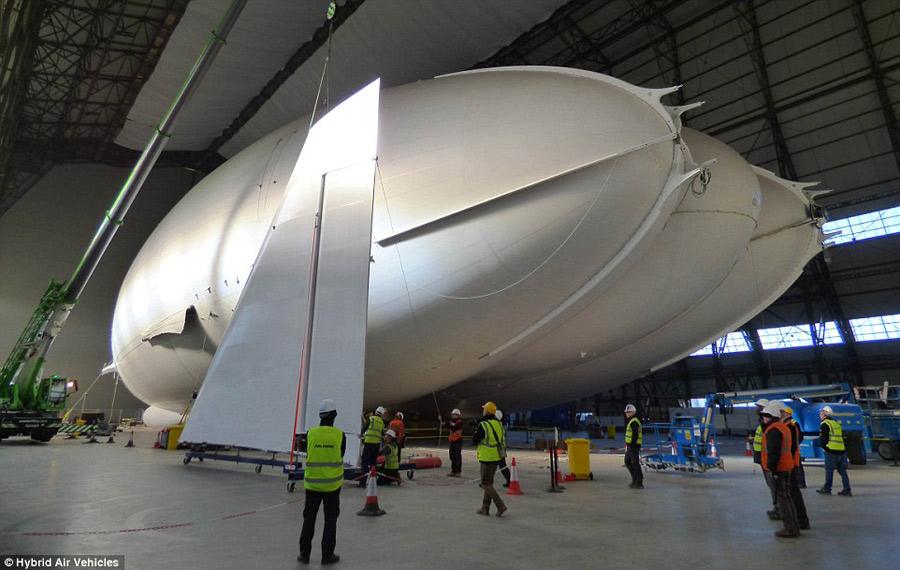
The first giant fin has now been attached to the ship, which is officially called the 'Airlander', according to Hybrid Air Vehicles who is constructing the aircraft. Two fins could comfortably cover the playing area of a tennis court.
The fin, measuring 9 x 11 metre, was secured to the hull using a series of cables and clamps. If you were to lay two tail fins side-by-side, they would comfortably cover the playing area of a tennis court.
The vessel was filled with 1.3 million cubic feet of helium - enough to fill 15 Olympic-sized swimming pools - in a test run last October.
Yet despite its impressive size and design, which is hoped to reinvigorate interest in using airships, the vehicle is attracting more attention for its appearance.
The October tests caused a stir on Twitter, with many spotting the airship's rather unfortunate resemblance to a human bottom.
In one case a head-on image of the airship has been altered to include a picture of Kim Kardashian, who is famous for her derriere.
The craft has already been tested with a successful hover test, with the hull being filled with helium and floated outside the aircraft hanger in November, but this will be the first test once the engines are successfully attached.
The date of the test flight has not been announced but the craft will be restricted to a 70-mile (112km) radius. If successful, an aircraft based on this prototype will go into production.

The world's largest airship, nicknamed the 'Flying Bum', is almost ready for its test flight next month. The 300ft-long (93 metres) shipped, officially named the Airlander 10, was originally developed as part of a US Army project but was scrapped by military bosses.
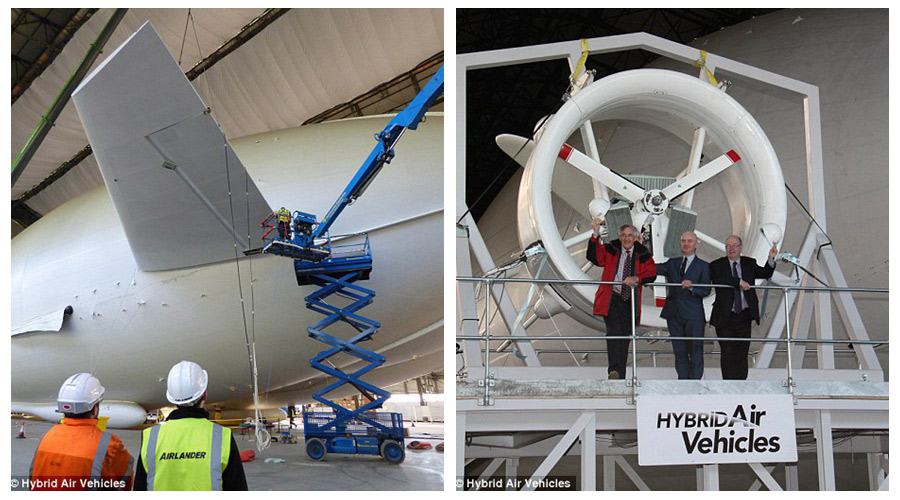
The fin, measuring 9 x 11 metre, was secured to the hull using a series of cables and clamps. If you were to lay two tail fins side-by-side, they would comfortably cover the playing area of a tennis court. Pictured on the right is the engine test rig.
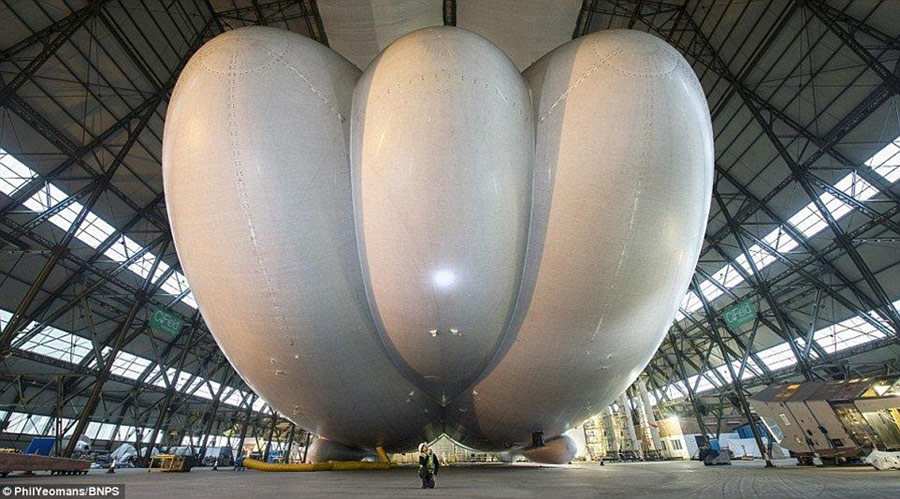
Three years since work began on the Airlander 10 (pictured), engineers are putting the final touches on the giant aircraft described as 'part plane, part helicopter.' The 300ft-long (93 metres) Airlander was originally developed as part of a US Army project but was scrapped by military bosses. It is now being converted to provide business and leisure flights in a hangar in Cardington, Bedfordshire.
During last year's 'floating' test, the craft was attached to four fork-lift trucks, each with a two-tonne block of cement to stop it being carried away, and driven the entire length of the hangar.
In its new position nearer the doors of the hangar, the £80 million ($1.1 billion) aircraft is now being fitted with its engine, fins and 'mission module' ahead of its first proper flight.
The craft did carry out a test flight in 2012, but next month's take-off will be the first under the hybrid aircraft's latest specifications.
Airlander is the largest aircraft in the world, bigger even than the Airbus A380 - but would be dwarfed by the historic zeppelins developed in Germany during the 1930s.
It produces 60 per cent of its lift aerostatically, by being lighter-than-air, and 40 per cent aerodynamically, by being wing-shaped, as well as having the ability to rotate its engines to provide an additional 25 per cent of thrust up or down.
This means the Airlander can hover as well as land on almost any surface, including ice, desert and water.
It will be able to stay in the air for two weeks at a time, cruising at more than 90mph (144km/h), and travel at heights of up to 20,000ft (6,100 metres) with a 10-tonne cargo.
Some have hailed the Airlander as the future of air travel because, unlike conventional aeroplanes, it emits little pollution and is not noisy enough to disturb people on the ground.

The Airlander produces 60% of its lift aerostatically, by being lighter-than-air, and 40% aerodynamically, by being wing-shaped, as well as having the ability to rotate its engines to provide an additional 25 per cent of thrust up or down. This means the Airlander can hover as well as land on almost any surface, including ice, desert and water.
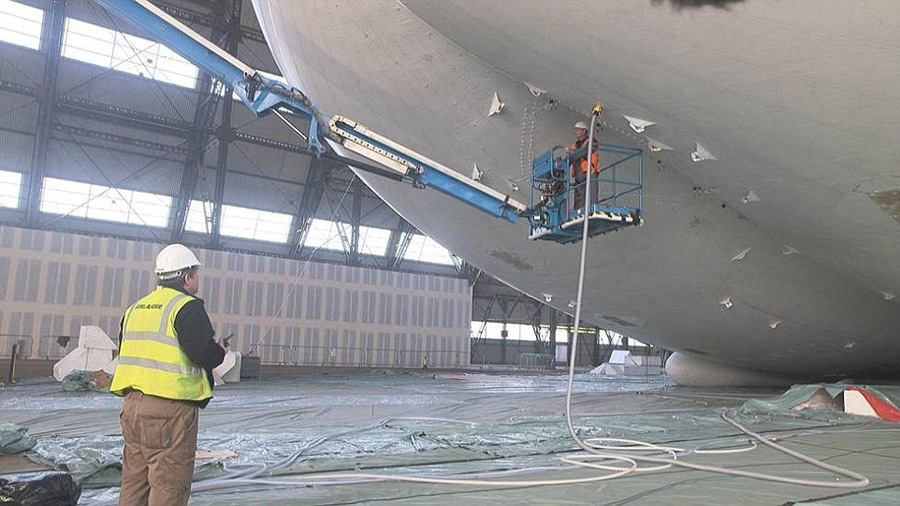
In its new position nearer the doors of its hangar, the £80 million aircraft (pictured) is now being fitted with its engine, fins and 'mission module' ahead of its first proper flight next month. The date of the test flight has not been announced but the craft will be restricted to a 70-mile (112km) radius. If successful, an aircraft based on this prototype will go into production.
It can take off and land vertically like a helicopter, which means it does not need a long runway to operate.
British firm Hybrid Air Vehicles was originally one of the contractors developing the vessel for the US Army under a $500million programme scrapped in 2012.
The company then bought the rights to develop the Airlander for commercial use - including use as a passenger aircraft that will carry 48 people at a time.
The vessel will also offer business services such as coastguard duties, military and civil surveillance, filming and academic research.
Engineers are hoping eventually to launch a sleeper service which could travel overnight between major cities for business customers.
Among the wealthy figures backing the project is Iron Maiden lead singer Bruce Dickinson, who has invested around £250,000 ($360,000) in the Airlander, as well as Carol Vorderman.
In its military incarnation, the aircraft previously embarked on a test flight in New Jersey, but the lift-off on 31 October was the first time the civilian version had left the ground.
In a blog post, Hybrid Air Vehicles explained: 'Already this month there have been a number of major attachments under the hull in preparation for the forthcoming First Flight of Airlander, beginning with the fuel module at the rear of the aircraft, followed by the payload beam, (which will support bulky external cargo) and finally, the cockpit and payload bay (which we term the Mission Module) were attached this week.'

The craft did carry out a test flight in 2012 in New Jersey (pictured) but next month's take-off will be the first under the hybrid aircraft's latest specifications. Some have hailed the Airlander as the future of air travel because, unlike conventional aeroplanes, it emits little pollution and is not noisy enough to disturb people on the ground.

The vessel will also offer business services such as coastguard duties, military and civil surveillance, filming and academic research. Engineers are hoping eventually to launch a sleeper service which could travel overnight between major cities for business customers. An artist's impression of how the Airlander will look when it is ready for long-haul flights across the world is pictured.
Unlike traditional airships, the Airlander has no internal structure but it becomes rigid through being filled with helium, at just above atmospheric pressure.
The super-strong hull material was designed by Warwick Mills and assembled by ILC Dover, the company that makes Nasa spacesuits.
It uses a woven fabric for strength on the inside, and a Tedlar layer for protection on the outside, around a mylar film to retain the helium.
Tedlar is used to lower how flammable the coatings on planes are, and is also used in raincoats and metal sheeting.
'The very latest materials, which are both strong and light, are used throughout the manufacture of our cutting-edge Airlander 10, ranging from the bespoke hull fabric to the mainly carbon composite Mission Module, Fuel Module, Ducts and engine support battens,' continued the firm.
'We produce less noise, less pollution, have a lower carbon footprint than conventional aircraft, and have longer endurance and better cargo-carrying capacity than any other flying vehicle.'
The Airlander's power comes from four 350hp, four-litre V8 diesel engines - two mounted at the front and two at the back.
With a length of 302ft (93 metres), a width of 143ft (44 metres) and a height of 85ft (26 metres), it is officially the world's largest aircraft - the biggest passenger plane, the Airbus A380, is only 240ft (73 metres) long.
However, the Hindenburg - the German zeppelin that crashed in New Jersey in 1937 with the loss of 35 lives - was three times longer than the Airlander.
The Airlander's base at Cardington is the historic home of the Royal Airship Works, set up in 1919 to build R101 airships in a failed attempt to damage German dominance of the industry.
Day|Week

 Train Attendant Recruitment Held in East China
Train Attendant Recruitment Held in East China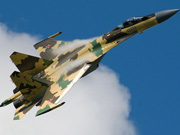 In pics: Russia's Su-35 fighter jets
In pics: Russia's Su-35 fighter jets Young monks learn kungfu in NE China temple
Young monks learn kungfu in NE China temple Scenery of Guzhu, thousand-year-old ancient village in E China
Scenery of Guzhu, thousand-year-old ancient village in E China China releases HD true color images of lunar surface
China releases HD true color images of lunar surface To-be flight attendants undergo training at snow-covered field
To-be flight attendants undergo training at snow-covered field Aerial photos taken on J-11 fighter
Aerial photos taken on J-11 fighter 'Coldest town in China' — a fairyland you don't want to miss
'Coldest town in China' — a fairyland you don't want to miss Deep love for breathtaking Hainan
Deep love for breathtaking Hainan Beautiful Chinese tennis player Wang Qiang goes viral online
Beautiful Chinese tennis player Wang Qiang goes viral online